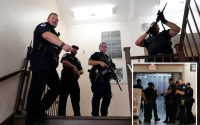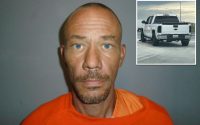Aftershock rattles Morocco after earthquake that killed over 2,000
AMIZMIZ, Morocco — An aftershock rattled Moroccans on Sunday as they prayed for victims of the nation’s strongest earthquake in more than a century and toiled to rescue survivors while soldiers and workers brought water and supplies to desperate mountain villages in ruins.
The disaster killed more than 2,000 people — a number that is expected to rise.
The United Nations estimated that 300,000 people were affected by Friday night’s magnitude 6.8 quake and some Moroccans complained on social networks that the government wasn’t allowing more help from outside.
International aid crews were prepared to deploy, but waited for the Morocco government to request their assistance.
“We know there is a great urgency to save people and dig under the remains of buildings,” said Arnaud Fraisse, founder of Rescuers Without Borders, who had a team stuck in Paris waiting for the green light. “There are people dying under the rubble, and we cannot do anything to save them.”
Help was slow to arrive in Amizmiz, where a whole chunk of the town of orange and red sandstone brick homes carved into a mountainside appeared to be missing.
“It’s a catastrophe,’’ said villager Salah Ancheu, 28. “We don’t know what the future is. The aid remains insufficient.”

Residents swept all the rubble off the main unpaved road leading to town and aid crews began arriving but pleaded for more help.
“There aren’t ambulances, there aren’t police, at least for right now,” Ancheu said.
Those left homeless — or fearing more aftershocks — slept outside Saturday, in the streets of the ancient city of Marrakech or under makeshift canopies in Atlas Mountain towns like Moulay Brahim, among the hardest-hit.
The worst destruction was in small, rural communities that are hard for rescuers to reach because the roads that snake up the mountainous terrain were covered by fallen rocks.

Those areas were shaken anew Sunday by a magnitude 3.9 aftershock, according to the U.S. Geological Survey.
It wasn’t immediately clear if it caused more damage or casualties, but it was likely strong enough to rattle nerves in areas where damage has left buildings unstable and residents feared aftershocks.
Friday’s earthquake toppled buildings not strong enough to withstand such a mighty temblor, trapping people in the rubble and sending others fleeing in terror.
A total of 2,012 people were confirmed dead and at least 2,059 more people were injured — 1,404 of them critically, the Interior Ministry reported Saturday.

“We felt a huge shake like it was doomsday,” Moulay Brahim resident Ayoub Toudite said. “Ten seconds and everything was gone.”
Flags were lowered across Morocco, as King Mohammed VI ordered three days of national mourning starting Sunday.
The army mobilized specialized search and rescue teams, and the king ordered water, food rations and shelters to be provided to those who lost their homes.
He also called for mosques to hold prayers Sunday for the victims, many of whom were buried Saturday amid the frenzy of rescue work nearby.

Aid offers have poured in from around the world and the U.N. said it had a team in Morocco coordinating how international partners can provide support.
About 100 teams made up of a total of 3,500 rescuers are registered with a U.N. platform and ready to deploy in Morocco when asked, Rescuers Without Borders said.
In a sign that Morocco may be prepared to accept more outside help, the Spanish military said it had sent an air force plane carrying an urban search and rescue team of 56 soldiers and four dogs to Marrakech. Foreign Minister José Manuel Albares said in a radio interview the deployment was in response to a request for help from Moroccan authorities.
Another rescue team from Nice, France, also was on its way.

In France, home to many people with links to Morocco, towns and cities have offered more than $2.1 million in aid, and popular performers are rallying to collect donations.
The epicenter of Friday’s quake was near the town of Ighil in Al Haouz Province, about 44 miles south of Marrakech. The region is known for scenic villages and valleys tucked in the High Atlas Mountains.
About 28 miles northeast of the epicenter, fallen walls exposed the insides of damaged homes, and piles of rubble blocked alleys.
In Moulay Brahim, a poor rural community of fewer than 3,000 people, many of the homes made of clay brick and cinder block were destroyed or no longer safe.

Devastation gripped each town along the High Atlas’ steep and winding switchbacks, with homes folding in on themselves and people crying as boys and helmet-clad police carried the dead through the streets.
”I was asleep when the earthquake struck. I could not escape because the roof fell on me. I was trapped. I was saved by my neighbors who cleared the rubble with their bare hands,” said Fatna Bechar in Moulay Brahim. “Now, I am living with them in their house because mine was completely destroyed.”
Hamid Idsalah, a 72-year-old mountain guide, said he and many other survivors had little future to look forward to as they lack the financial means to rebound.
Rescuers backed by soldiers and police searched for victims in collapsed homes in the remote town of Adassil, near the epicenter.
Military vehicles brought in bulldozers and other equipment to clear roads of rocks that crumbled off mountainsides, the state news agency MAP reported.

Ambulances took dozens of wounded from the village of Tikht, population 800, to Mohammed VI University Hospital in Marrakech.
In Marrakech, where authorities were assessing the damage, large chunks were missing from a crenelated roof, and warped metal, crumbled concrete and dust were all that remained of a building cordoned off by police tape.
Tourists and residents lined up to donate desperately needed blood. Jalila Guerina said she ran to help when she learned of the need because of her duty as a Moroccan citizen.
“I did not even think about it twice,” she told The Associated Press, “especially in the conditions where people are dying, especially at this moment when they are needing help, any help.”
In the market, stray cats clambered over piles of stones and wooden bars, but shoppers were scarce at stalls set up under parasols by food and souvenir vendors.


